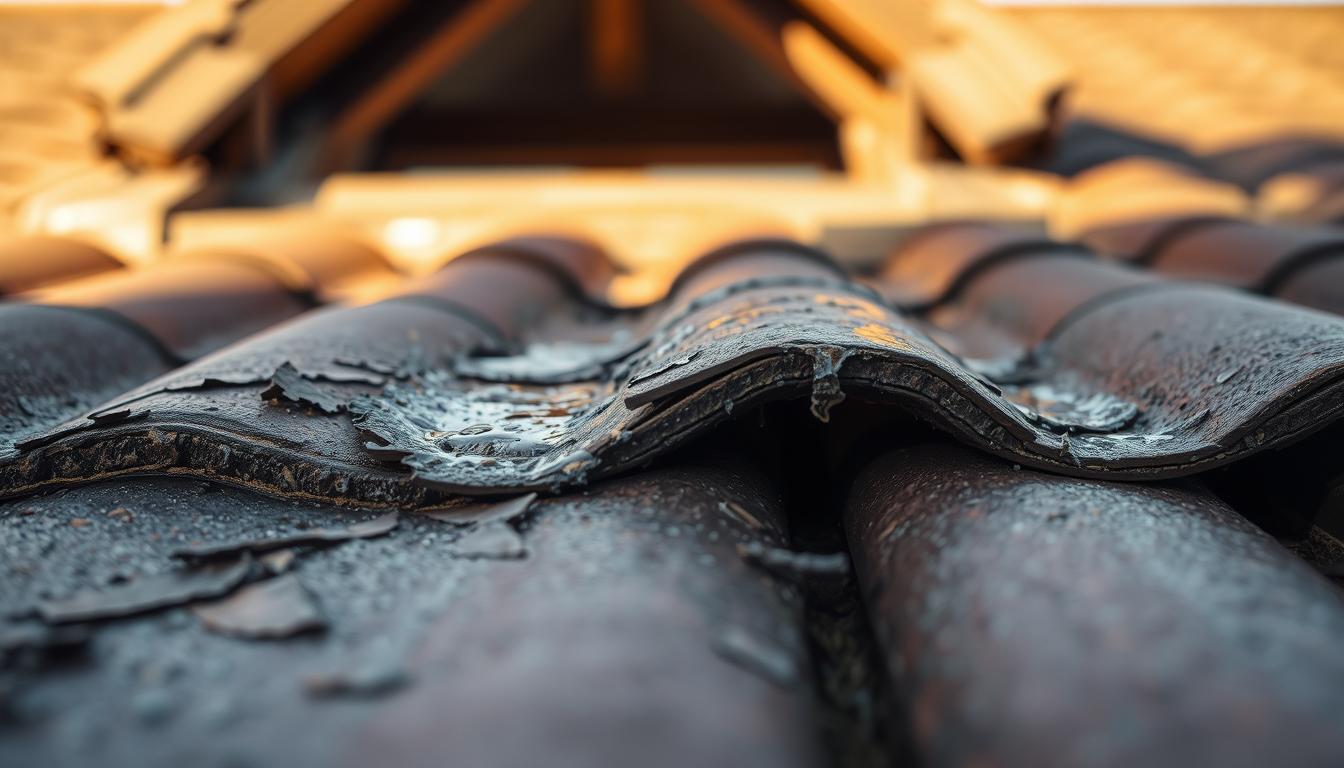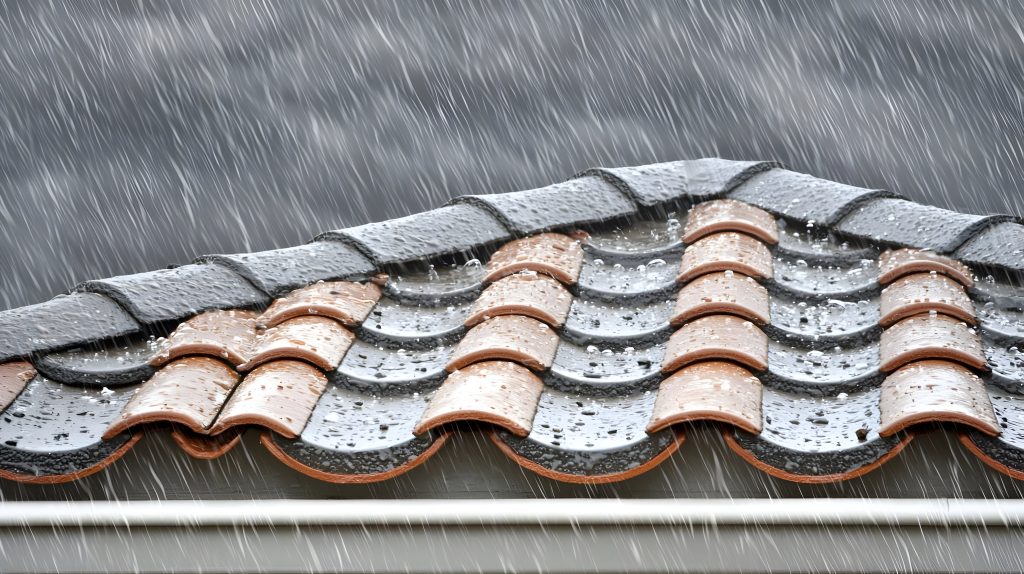Water damage tops the list of common home insurance claims in South Africa. Surprisingly, little leaks can turn into big, costly problems. Here’s a quick guide to help you understand the costs for fixing a leaking roof in South Africa, with predictions for 2025 prices.

The cost to fix your roof in 2025 depends on four key factors: the size of your roof, how bad the damage is, what your roof is made of, and how complex the job is. Small jobs, like adding sealant or patches, are the cheapest. Replacing tiles or fixing flashings falls in the middle price range. But, fixing the whole roof structure or adding new waterproof layers costs more.
You’ll need to pay for a roof check before getting any repairs done. After that, repair services will give you a detailed quote. It will show the labor and materials costs per square meter. Remember, the price can vary depending on where you live in South Africa. Big cities like Johannesburg and Cape Town might cost you more because of higher labor costs and traffic delays.
The final price can also change based on whether you need a quick fix or a whole new roof. It also depends on if you need scaffolding, special permits, or other extra services like cleaning gutters or painting the roof. This guide gives you an idea of what typical roof repairs might cost in South Africa by 2025.
Key Takeaways
- Final roof repair cost in 2025 depends on size, damage, material, and complexity.
- Expect a professional inspection fee followed by itemized cost estimates per square meter.
- Johannesburg and Cape Town often have higher averages due to labor and access factors.
- Minor leaks cost less; flashing, membranes, and structural fixes increase the total.
- Bundled services like gutter cleaning or roof restoration can change what repairs will cost.
- Choosing spot repairs vs. full replacement is a major driver of how much does roof repair cost.
Factors Influencing Roof Repair Costs
Before you hire a team in South Africa, you need to consider a few things. The cost to fix a roof depends on the work needed, how easy it is to get to the roof, and what materials are available. The size of the roof, the area that needs repair, and how complex the job is also play big roles. These factors influence the price from the initial visit to the last application of sealant.

The Extent of the Damage
Fixing a small leak or a broken tile takes less time and fewer materials. But when water damage reaches the wood supports or insulation, it gets more expensive. This is because it requires more work and materials to fix the structure. The larger the damaged area, the more it costs to repair.
- Localized issues: quick fixes with limited materials.
- Widespread damage: fixing wood, ceilings, and needing more time to dry.
- Access and safety needs: harder jobs on steep roofs also cost more.
Roofing Material
Different roofs need different repair methods and time. Tile roofs require finding matching pieces and careful handling. Asphalt shingles are quicker to replace, but might need new protective layers underneath. Metal roofs need special connectors and sealing products. The cost changes based on the roofing material, like Marley tiles, Owens Corning shingles, or Chromadek steel.
Choosing materials also depends on how large the repair section is. Bigger areas might offer savings per unit, but detailed work on edges or junctions still influences the final cost.
Type of Roof
Flat and slanted roofs have their own set of challenges. Flat roofs might need special coatings, while slanted roofs require safety measures and more effort to transport materials. Detailed designs with extra features like skylights or chimneys add more steps, affecting the price for each repair visit.
The cost of labor is tied to the roof’s size and how many openings it has. Larger roofs have higher total costs, but the price per square can decrease because of the job’s scale. The complexity of the task varies with different roof styles, affecting overall prices.
Understanding Different Types of Roof Leaks
Damp marks on ceilings, musty attic smells, or stains on fascia boards might mean a roof leak. In places like Gauteng and the Western Cape, wind and harsh UV rays often cause roof leaks. Knowing whether you need minor, moderate, or major repairs helps plan your time and budget. This way, you can fix leaks before they get worse and your roof might become unsafe.

Identifying Minor Roof Repairs
Minor repairs focus on small issues like cracked tiles or a small hole in the roof. They might need new tiles, resealing, or a simple patch. These leaks are common and not too costly to fix.
- Quick action means a small repair area and less materials needed.
- The work is minimal, keeping labor costs low.
- You might notice a single drip or a small stain after it rains.
Moderate to Major Repairs
Moderate repairs are needed when parts like flashing around skylights fail. Or, if a few tiles slip out of place. These issues require bigger fixes, like new underlayment, and more care to stop leaks.
- This often includes replacing certain roof parts and fixing ridges.
- The job takes longer as more of the roof needs fixing.
Major repairs are for serious damage, like soaked insulation or failed roof support. This might mean partly replacing the roof and doing carpentry. At this point, a simple patch won’t do; it’s about rebuilding.
- These repairs include new supports and waterproofing to fix the damage.
- The extent of damage can lead to temporary fixes until work is done.
Understanding if you need minor, moderate, or major repairs sets clear repair goals. It helps choose the best fix plan. This way, you save as much of the roof as you can while fixing leaks properly.
Average Costs in 2025 for Roof Repairs in South Africa
To plan for 2025, check how labor and materials are priced. Prices are usually based on area, per square or per square metre, plus a small job fee. Costs can rise due to location, safety needs, and matching existing materials, especially with tall houses.

Cost Per Square Meter
Contractors keep bids fair by charging per unit. This includes costs for removing, waterproofing, and redoing finishes, by area. Small areas cost more because of the fixed costs for crew setup and safety.
- Complex roof features like valleys and skylights make repairs pricier.
- Flat roofs and ridge caps also bump up the price.
- Adding gutters or pipes affects the total, even with per metre pricing.
In Johannesburg and Cape Town, expect to pay more than the average. These cities have higher costs due to difficult access, traffic, and the demand for skilled workers, unlike smaller towns.
Higher Repair Costs
In Johannesburg, high buildings and expert workers mean higher prices. Cape Town’s crowded areas show similar trends. Costs rise with big timber, tile, or comprehensive waterproofing jobs.
- Minor repairs may be pricier due to initial setup costs.
- Throwing away old materials, fixing gutters, and painting roofs can increase the price.
- Unseen water damage found during repairs can also raise the cost, even with a set price per area.
Itemized quotes break down costs, helping compare different cities. They show why some repairs are more expensive than others.
Cost to Repair a Leaking Roof: What You Need to Know
The cost to fix a leaking roof varies. It is based on how big the problem area is and if parts like underlayment and flashing are okay. Always ask for a detailed check for leaks, temporary weatherproofing if it’s going to rain, and the right materials to fix your roof.
To understand roof repair costs, get quotes that break down the expenses. This includes labor, materials, waste removal, and VAT separately. Make sure they mention specific brands and quality, like SABS-approved underlay and the right kind of flashing. Before and after photos are key for transparency.
The ease of accessing your roof impacts the cost of repairs. If your roof needs scaffolding or has hard-to-reach entries, it will cost more. The final price will cover safety and cleanup, not just the repair itself.
It’s smart to ask if there’s a warranty on roof leak repairs and how long it lasts. Consider the cost of repairs against how old your roof is. Sometimes, replacing the whole roof is more cost-effective than constant small repairs.
When comparing proposals, look for details about the leak’s exact location, the products used, and how much they’ll use. Detailed quotes help you avoid extra charges that don’t add real value.

Keep a log of all inspections, moisture levels, and fixes for each part of your roof. Good records help with warranty claims and make any future repairs easier and cheaper.
The Role of Roofing Material in Repair Costs
The cost to fix a roof involves labor, materials, and expertise. These differ based on the roof type. Every type of roof handles South Africa’s weather differently. The repair cost fluctuates with material suitability, site accessibility, and the quality of the initial installation.

Asphalt Shingles
Fixing asphalt shingles is often quick. The materials are readily available, and replacing a shingle is swift. Labor costs are less, and sealing small sections is straightforward, especially with self-stick membranes in valleys.
Finding a match for older roofs in color and style might be tough. Sometimes, you need to repair a larger area for a uniform look. In places with strong sunlight, make sure to use the right adhesives and nails for this type of roof.
Tile Roofs
Handling a tile roof requires care. Removing a cracked tile is a delicate task, as the supporting structures might also need fixing to prevent further leaks. If special tiles are needed, costs and effort can increase.
By the sea, salt can make tiles more fragile. Choosing the right underlay can make repairs last longer. The time to fix can be longer if it’s hard to find matching tiles.
Metal Roofs
Metal roofs may need special parts like color-matched screws and certain sealants. Often, leaks appear where the roof panels overlap or connect to the building. Fixing these might involve securing the panels again, installing new sealing strips, and applying sealant.
If the panels are rusty or not aligned right, part of the panel may need replacing. In areas with frequent storms, choose materials that can handle the conditions. The cost and time for repairs depend on the roof’s complexity and how easy it is to get to the site.
Roof Inspection: Why It’s Important
Getting your roof checked before summer storms hit can save your budget and home. A detailed roof inspection ensures your roof can withstand the wind-driven rain common in South Africa. Trusted roofing methods and a professional approach make sure your roof is secure and leak-free.
Tip: It’s wise to get your roof assessed after bad weather or if you notice new ceiling stains. These small signs could mean there’s bigger roof damage you can’t see.
Inspect for Hidden Damage
Leaks often begin where you least expect, far from visible indoor marks. Inspectors look for water paths in the attic, checking for wet insulation, mold, and wood rot. They make sure everything, including flashings and gutters, is checked to keep your roof safe in storms.
- Thermal imaging and moisture meters identify damp areas hidden beneath the surface.
- They also check moisture in structural areas to stop further damage.
- Inspecting water flow on various roof types helps in addressing issues promptly.
Professional Roof Inspection Services
A professional roof inspection offers photos, detailed notes, and a list of needed repairs. This info helps you plan and budget for roof maintenance before small issues become big problems. Experts will guide you on whether small fixes, partial re-sheeting, or a full restoration is needed for rainy seasons.
- Reports highlight issues like flashing failures and membrane blisters.
- They prioritize repair recommendations to secure your roof quickly.
- Local knowledge of common roofing materials aids in accurate assessments.
Booking a roof inspection with the seasons can cut unexpected costs, protect your home’s interior, and keep your roof storm-ready.
Choosing the Right Roofing Contractor
Hiring a qualified and open roofing contractor protects your home and budget. They will visit your home to understand the project. They’ll explain the work needed and discuss costs beforehand. This approach ensures your quotes are accurate.
Checking Credentials and Reviews
Start by checking if they are registered, have insurance, and are approved to use certain roofing materials. Ask for references from recent projects similar to yours. Also, look for current reviews focusing on their roofing and safety standards.
Seek proof of their connection with known organizations in South Africa and their expertise with familiar brands. A reliable team will talk about how they plan to safely access the roof and the rules they follow on-site.
Quotes and Estimates
Always request an inspection before getting an estimate. Avoid rough guesses that don’t consider your job’s specific needs. The quote should detail the work area, materials, and if it includes gutters or downspouts.
Ensure you’re given information about possible delays, warranty details, and get everything in writing. Compare multiple quotes to see who offers the best value. A detailed proposal will show you different repair options, helping you decide based on time and cost.
Common Roof Leak Repairs and Their Costs
Find and fix leaks smartly to control costs, especially in South African weather. Small problems on a common roof turn into big expenses if runoff is blocked or flashing fails. Do tasks like roof waterproofing, roof painting, and gutter repair together. This slows down wear and cuts down on future water damage.
Fixing Leaky Chimneys
A leaky chimney can mean bad flashing, no counter flashing, or weak mortar. Fixing it may involve new flashing in aluminum or copper, fixing brick joints, and installing a cricket for bigger stacks. Use good sealants for repairs that last longer.
- Light service: reseal flashing laps and fix minor mortar cracks.
- Mid-range: replace all flashing and fix visible joints.
- Heavy: rebuild damaged parts and add a cricket.
Gutter and Downspout Repairs
Blocked gutters push water under eaves and into your home. Fix it affordably by cleaning, adjusting slope, fixing joints, and replacing rusty parts. To avoid future issues, add leaf guards and ensure outlets are big enough for heavy rains.
- Cleaning and adjusting slope ensures quick runoff.
- Fix seam leaks; switch out rusty parts.
- Install bigger outlets or more downspouts for heavy rain.
Repairing Attic and Ceiling Leaks
After fixing the roof, repair the inside damage. Change wet insulation, handle mild mold, and replace stained ceiling before final roof painting. Ensure the outside is waterproof and, if needed, do some roof restoration to keep it dry.
- Shingle and tile fixes: replace broken tiles and reseal valleys.
- Flat roof work: fix blisters, re-weld laps, or add new capsheets for waterproofing.
- Combine tasks: do gutter repairs with selected coatings for lasting leak repair.
Prices change based on location, height, and materials used. Keep costs down by focusing on the main issue, directing water away properly, and choosing finishes that stand up to UV rays and wind on a common roof.
Full Roof Replacement vs. Spot Repairs
Choosing between fixing specific areas or getting a new roof is big. Think about the current roof’s condition, your budget plans, and how roofs hold up against South Africa’s weather.
Think long term. Balance today’s costs with potential expenses over the next 5–10 years. This is key if several parts of the roof are failing or if you’re considering solar panels.
When to Opt for Full Roof Replacement
- Issues in many roof areas mean you might need a complete new roof.
- Aging roofs benefit from full replacement to ensure everything is waterproof and warranties are up to date.
- Fixing leaks repeatedly suggests a need for a whole new roof.
- For solar plans, a fresh, guaranteed roof makes installation and upkeep easier.
- Replacing everything can boost your roof’s overall performance.
Benefits of Spot Repairs
- Single leaks with no surrounding damage make quick fixes a smart, affordable choice.
- Minor repairs can add years to a roof’s life without a full replacement.
- For newer roofs, a timely fix can stop leaks while you plan for a future upgrade.
- Comparing repair costs over time may show when it’s time for a bigger roof project.
- An expert inspection can guide decisions on fixing one area or opting for more extensive work.
Bottom line: Match your repair choice to the roof’s age, damage, and your future property plans. This helps decide between patching up or getting a new roof.
Cost Saving Tips for Roof Repairs
Staying ahead of problems reduces repair costs. A good maintenance plan lets you monitor your roof, plan budgets, and avoid surprise expenses during stormy seasons in South Africa.
Regular Roof Maintenance
Create a habit of cleaning gutters and downspouts. Also, remove debris and trim nearby branches. This reduces the risk of leaks and ensures water flows off your roof quickly.
Have your roof inspected yearly. This helps find issues like loose ridge caps or cracked tiles early, saving money on emergencies. It also prepares you for any big repairs needed soon.
Document each roof inspection with photos and invoices. This history helps identify problem areas, guiding decisions on repairing or upgrading parts of your roof cost-effectively.
Addressing Minor Repairs Promptly
Fix small problems immediately if you notice ceiling stains or missing shingles. Quick action prevents water damage and saves on costly repairs for structural damages or mold removal.
For older roofs, consider specific restorations like re-coating or waterproofing. Early repairs extend your roof’s life and control future repair costs.
When getting repair quotes, look for detailed breakdowns of costs. Understanding the specifics helps you choose between minor repairs and more significant upgrades that save money in the long run.
Conclusion
Before taking action, it’s smart to have clear figures. In South Africa, fixing a leaky roof can cost differently. This depends on how bad the damage is, what your roof is made of, and the kind of roof you have. Places with lots of people, like Johannesburg and Cape Town, might have higher prices.
Start with getting a pro to check your roof and ask for a detailed quote by square meter. This will help you figure out how much you’ll spend. You can also compare offers from reliable contractors this way.
Think about the type of materials, common repairs, and when to fix parts instead of replacing the whole roof. This will help you plan your spending. The material of your roof, like tile, metal, or asphalt, affects the price differently. Roofs with complicated designs may cost more to fix because they take more work.
Make sure to get a breakdown of the costs for things like flashings, underlayment, and making your roof waterproof. This way, the final price reflects the actual work done. Clear costs lead to no surprise expenses.
Look for well-known companies and teams in areas like Gauteng, the Western Cape, and KwaZulu-Natal. Balance the cost with the quality of work and guarantees. If proposals differ, ask why before agreeing. Clear, detailed offers let you understand the costs and keep you from unexpected charges.
Being ahead of the game helps. Keep your gutters clean, fix leaks quickly, and have your roof checked regularly. This approach lessens your overall spending. Taking care of your roof regularly means lower repair costs, lessens water damage, and keeps your roof in good shape longer, no matter the type.
FAQ
How much does it cost to repair a leaking roof in South Africa in 2025?
Repair costs for roofs in 2025 will vary based on material and size. Factors like damage extent and job complexity also play a role. Starting with an inspection fee, costs then scale based on square meter rates for labor and materials. In cities like Johannesburg and Cape Town, prices may be higher. Small fix-ups like sealing or flashing are cheaper than major structural jobs.
What factors affect the final cost to repair a roof leak?
Different elements affect your roof repair bill. The roof’s size, material type, and its design complexity matter. Costs also go up if there’s water damage or the need for extra services like gutter cleaning.
Do roof repair costs vary depending on the roofing material?
Yes, the roofing material impacts repair cost. Asphalt shingles are usually cheaper and quicker to fix. Tile roofs might need more delicate handling, and metal repairs could call for specific sealants. Each material has its own repair times and product needs.
How do different roof types influence pricing?
Flat roofs often need more costly waterproofing work. With pitched roofs, safety and handling add to the cost. Complex roofs with many features take longer to fix, lifting your overall bill.
What are common roof leaks and their typical fixes?
Leaks often come from cracked tiles or damaged shingles. Fixes may involve tile replacement, resealing, or flash repair. Problems like gutter overflows also cause leaks, needing gutter repair.
What do minor roof repairs usually include?
Minor repairs tackle small issues like a broken tile or a small hole. These are less expensive and are charged with a minimum rate plus material and labor costs.
When do moderate to major repairs apply?
More serious repairs are needed when there’s significant flashing failure or water damage. These situations may require extensive work, such as re-roofing, which raises costs.
What is the typical cost structure per square meter in 2025?
Roofing quotes often come per square meter, including labor and materials. Small repairs may seem costlier due to setup needs. Complex and high-access jobs are priced higher.
Why are prices in Johannesburg often higher?
In Johannesburg, factors like labor rates and building access raise prices. Traffic and safety measures add to the complexity and cost of roof repairs.
What should you look for in a professional roof inspection?
A thorough inspection should locate leaks and assess damage. It includes photos, a report, and repair priorities. Tools like thermal imagers can show hidden issues, affecting costs.
What should be included in a detailed roof repair quote?
Your quote should break down costs by area, listing materials, labor, and extra fees. Ask about warranties and if gutter work is covered.
How do asphalt shingles, tile roofs, and metal roofs compare for leak repairs?
Shingles are cheaper but might need big patches. Tile repairs need careful matching, and metal might require specific fixes. Each has unique challenges and costs.
Do you always need a full roof replacement for a leaky roof?
Not always. Small repairs work if damage is limited. A full replacement is better for widespread issues. Consider long-term costs of repeated fixes.
How can you save on roof repair costs?
Keep up with maintenance and fix minor issues quickly. Combine jobs like gutter work for better rates. Document all repairs.
How do gutters and downspouts affect roof leaks and pricing?
Blocked gutters can cause leaks. Fixing this involves cleaning and possible replacement. These additions can increase initial costs but save money long-term.
What extra costs should you expect on complex roofs?
Rooftops with extra features need more work and safety measures. This makes the job pricier due to increased labor and materials.
Will the size of the roof change the price per square metre?
Yes. Larger roofs get better rates. Small jobs might seem pricier due to the setup and matching required.
Can hidden water damage affect the final cost?
Yes, hidden issues like wet insulation add to your bill. Change-order policies help manage these unexpected costs.
How do you choose a trusted roofing contractor?
Check credentials and reviews. Ask for references and compare quotes. Good roofers discuss risks, warranty, and repair options clearly.
What is included in chimney leak repairs?
Chimney repairs might need new flashing or sealing. These tasks are more complex and often costlier due to the detail needed.
What about repairing attic and ceiling leaks after a roof fix?
Post-leak repairs can require insulation replacement and mold treatment. These are quoted separately but are vital for full restoration.
How quickly should you act on a roof leak?
Quick action is crucial. Small leaks can lead to big repairs if not addressed. Fast fixing helps avoid increased costs in 2025.




